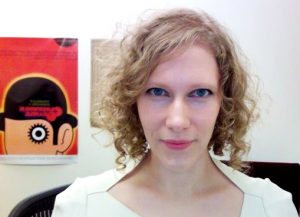Eugenie Brinkema: A critical humanist who happens to work on film
I find myself excitedly telling my friends (and family) about the work I have done in these [film] classes [. . .]. For me, [. . . ] thinking about issues of representation, spectatorship, suffering, violence, horror/fear, gender roles, capitalism, psychoanalysis, subjectivity, power dynamics, media, and modern texts [. . . ] feels more applicable and interesting to all of our daily lives than a random thermodynamics equation that I might jot down in another class. —C.H., Brain and Cognitive Sciences, Class of ’15

Professor Eugenie Brinkema
Walk by
Professor Eugenie Brinkema’s office sometime when she is talking with a student, and you will hear a wild jumble of seemingly unconnected phrases: “sprocket holes,” “Irene Dunne’s eyebrows,” “Hobson’s choice,” “Lear on the heath,” “Althusser and Baudrillard,” “horror as void.” (If you want to hear more of what she and her students talk about, go to Marisa Fryer’s interview
here.) Brinkema readily discusses anything, the more bizarre and random the better. “I was a court brat,” she explains. “My mother is a U.S. District Court judge, my father a computer security analyst for the courts. I grew up arguing; I was on nationally-competing debate teams in high school and college.” But something unexpected happened at Yale. “I was studying philosophy and thought I would go to law school. But all of a sudden, I was taken with the problem of aesthetics. I loved Kubrick’s strange, stylized
Eyes Wide Shut; I became obsessed with Pasolini’s
Salò. I took film classes and began to think about film through philosophy—and about violence, ethics, metaphysics, and politics through film. It was an intellectual coming home.” “Home” is one location for the aesthetics of violence Brinkema studies. Her 2014 book,
The Forms of the Affects (Duke University Press) analyzes extreme emotions (disgust, anxiety) in filmic art, in domestic tableaux as well as a broad spectrum of other spaces. Her current work focuses on aesthetics, death, and the horror film, and for a completely different version of her thinking about negative emotions and horror, check out her foray into home-moviemaking
, “Zombie Gingerbread Christmas,”in which she and her family constructed a gingerbread house complete with bloody, flesh-eating creatures scattered about a landscape of wreckage and ruin. “The challenge was to articulate the [gingerbread] arms so that they could gesture realistically,” she says. Brinkema hastens to point out that she is not a film historian or filmmaker, but a critical humanist who happens to work on film. She loves the theoretical and aesthetic challenges of pop culture. “I have a high kitsch tolerance,” she says, and a wide range of enthusiasms. She owns a Freud doll sporting a cigar, a West German piggy bank with a painted black mouth (“in the precise shape of Lee Miller’s lips”), lots of Tom Brady posters, a cameo with Hitchcock’s face on it, a stack of surrealist postcards by the Quay Brothers. Like her other passions—horror, violence, transgressive sexuality—kitsch insistently challenges mainstream taste and conventional ethics; it is an exuberant expression of desire, stretching the limits of the imagination. One gets the idea that Prof. Brinkema’s lectures have a similarly exhilarating effect on her students. Says one of them, “it’s really cool that [ . . . ] I got to read selected excerpts from Foucault, Freud, and the Marquis de Sade, thought about all of the aforementioned issues, and watched
The Human Centipede, Texas Chainsaw Massacre, Ringu, and
Shaun of the Dead” (C.H.) The admiration goes both ways. When asked what she loves about MIT students, Brinkema gets right to the point. “One, they are, at heart, structuralists. They talk joyfully about the abstractions of form.
They love thinking about and through systems.” Early in the semester Brinkema introduces new film students to “plot” vs. “story,” explaining the different and often competing structures of each. Students map film elements on the board. “They’re happy talking about structures, patterns, rhythms, deviations. As am I.” Secondly, she says, “MIT students respect
hard thinking. They like hard classes, hard theory.” Brinkema quotes a professor from graduate school (she has graduate degrees from the University at Buffalo and Brown University), saying that theory involves “thinking without guarantee.” It asks questions about ethics, violence, form—questions that open up new questions, “that make your head hurt,” Brinkema says. She respects her students’ enthusiasm for the hard questions—and clearly they respond. “To watch film,” she tells them, “is to read irresponsibly.” She means that art such as film is not “responsible” to a national cinema, a historical period, a social movement. You have to work through its issues on its own terms. As her students quickly discover, Brinkema’s classes give them the tools they need for testing their assumptions about art, thought, and emotion. One student, Marisa Fryer, was so inspired by her work in film studies that she embarked on a project to watch a film a day for an entire year. In her interview
here, she talks about how she came to major in Literature along with Civil and Environmental Engineering and to explore a range of topics that included horror, Czech cinema, adaptations of Shakespeare and Melville, and whatever is “weird” in film. She is the
2015 winner of the Peter S. Donaldson award for excellence in Literature and contributions to the Literature community. At the ceremony to bestow the award, Brinkema said of Marisa’s enthusiasm for film that if the assembled students could understand what it feels like to watch a student “embrace your lifelong scholarly interests with as much passion as you do,” then every one of these undergraduates “would surely become professors. It’s an incredibly fun job.”
Interviewer:
Wyn Kelley

